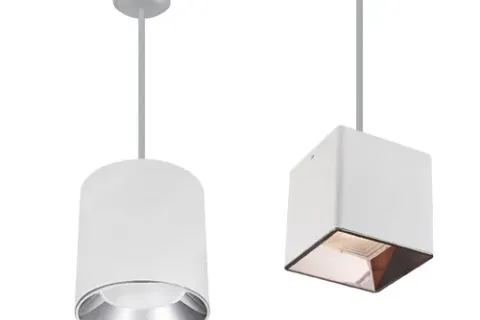If you're looking for simple, even lighting, round LED lamps are undoubtedly the better choice. If you prefer a modern, unique decorative effect, square LED lamps are more suitable. Ultimately, consumers can choose the most suitable LED lamp based on their space needs, design style, and desired lighting effects.
LED lighting fixtures usually have built-in heat dissipation devices to reduce heat, but if the working environment temperature is too high, the heat dissipation effect may be insufficient, which will shorten the service life of the LED lights and even cause premature failure.
The most notable feature of track lights is the adjustable direction and angle of the fixtures. This allows them to precisely illuminate specific areas or objects, making them particularly suitable for accent lighting or display lighting. Recessed LED lighting, on the other hand, is fixed in place and cannot be adjusted in direction.
A significant advantage of LED lighting is its compact size, wide variety, and adaptability. Whether recessed, strip lights, spotlights, or sensor-based lighting, LED lighting can be customized to suit the specific closet space.
One of the most direct differences is the type of light source. LED downlights use LEDs exclusively as the light source, while recessed lights can use a variety of different light sources. Traditional recessed lights often use halogen lamps, incandescent lamps or fluorescent lamps, but with the development of LED technology, more and more recessed lights are beginning to use LED light sources.
• General bedroom: 30-40 lumens/m2 • Large bedroom or master bedroom: 40-50 lumens/m2 • Bedside area: The brightness of the bedside lamp should be moderate, generally around 100 lumens (can be adjusted appropriately according to specific needs).
LED downlights usually have a larger beam angle, usually between 60° and 120°. This means that they have a wider range of illumination, can illuminate a larger area, and provide uniform light distribution In contrast, LED spotlights have a smaller beam angle, usually between 15° and 45°, and focus on concentrating light on a specific area or object.
If your LED downlight is a removable bulb type, the disassembly steps are relatively simple. Usually, the bulb of the LED downlight is fixed to the lamp holder by a clip or thread. Gently twist or press the clip to remove the bulb from the lamp holder.
Places that are not suitable for installing LED lighting downlight include: 1. Wet or high humidity environment 2. High temperature or extreme temperature environment 3. Too low ceiling space 4. Frequent switching scenes 5. Places that require extremely strong light output 6. Art galleries or special exhibition spaces 7. Direct exposure to strong impact or vibration environments
Reasons for LED lighting downlight flickering: 1. Unstable power supply voltage 2. Driver power failure 3. Quality problems of the lamp itself 4. Improper installation 5. External electrical interference 6. Temperature factors
High-quality LED lamp beads can provide stable light output and avoid problems such as uneven color temperature or inconsistent brightness. Consumers should choose LED lamp beads with high light efficiency and long life to ensure the stability of their lighting effects.
When integrated LED lighting lamps burn out, the possible effects are: 1. Safety hazards (short circuit, overheating or electrical fire) 2. Equipment damage 3. Impaired lighting effect












